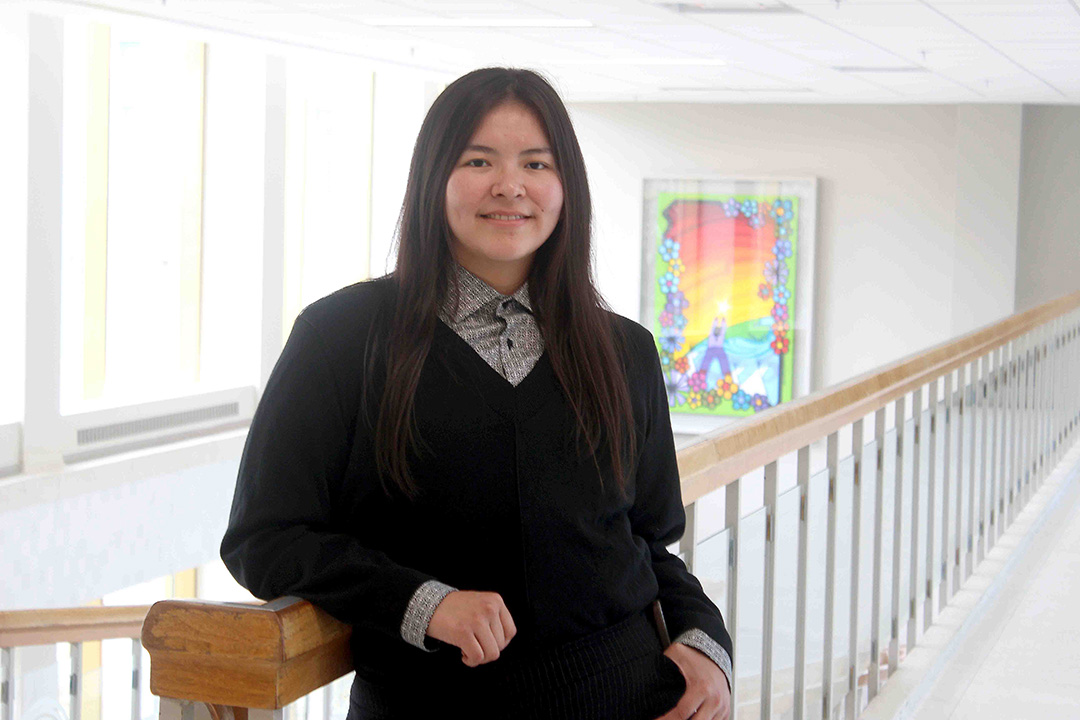
Indigenous student embraces new role at USask
Nitanis Bear credits ISAP learning communities for establishing connections and retention at USask.
By Kristen McEwenAs Spring Convocation approaches, Nitanis Bear’s role at the University of Saskatchewan (USask) is changing--from student to staff member.
Bear will be receiving her Bachelor of Arts degree in English when she crosses the stage at Merlis Belsher Place on June 4. She is balancing that accomplishment alongside her new role as the Indigenous Student Recruitment Officer at the College of Arts and Science. Bear is Cree from Mistawasis First Nation and Pelican Narrows.
“I was really sad to be leaving my capacity as a student,” she said. “My whole identity was being a student here.”
Attending USask had benefits for Bear. Since she lived in Saskatoon, campus was close – the proximity making it easier to help take care of her younger sister. But it was the community that made Bear stay.
“My first day on campus, I remember I was so scared,” she said. “I’ve never been scared for high school or anything before, but it’s a huge place.”
Before classes started 2018, Bear met with an advisor from the Indigenous Student Achievement Pathways (ISAP) program, then known as ASAP (Aboriginal Student Achievement Program).
The advisor made Bear feel comfortable and helped quiet the fear and anxiety she was experiencing.
“He was really making it so comfortable as a support staff (member), that first person that you meet in university.”
The advisor recommended classes that Bear should take in her first year based upon her interests and recommended the pathway she should join — the Willow Hoop Learning Community.
“I found that when I walked in there, it was just a feeling of community that I had been missing for years,” she said.
ISAP learning communities bring first-year students together with shared academic goals and introduce upper-year peer mentors. The communities are designed to establish connections and support between peers. The Willow Hoop Learning Community brings together students who are studying humanities and fine arts subjects.
“It’s just such a special experience to just guide each other and say, ‘Oh, I don’t know either, but let’s go find out,’” Bear said.
When she started classes at USask, Bear knew she wanted to pursue an English degree.
“I’ve always loved books as a child,” she said. “Growing up, my positive validation was from school. I strived to get good grades, and then I found out that there was such a thing as creative writing.”
“I remember being in Grade 3 and just thinking, ‘Wow, this is for me. I want to be a writer when I grow up.’”
All through high school, Bear continued to read, excelling in her English classes. At USask, she felt some pressure from family members to choose other majors, but she insisted she wanted to focus on English.
“Choosing my English degree was this way of being true to my inner child in a way and rediscovering my autonomy as a person.”
While balancing her university courses, Bear had the opportunity to try playwriting. Prior to the pandemic, she joined the Circle of Voices program at the Gordon Tootoosis Nīkānīwin Theatre (GTNT) and wrote the play, You Didn’t Hear It From Me. The play was performed at GTNT in 2022. The Circle of Voices program supports young Indigenous artists as they explore storytelling and learn artistic and theatrical skills.
In her second year of university, Bear moved out to live on her own. She was working to pay bills, maintain her apartment, and support her younger sister.
“School kind of took a back burner for me, and that was something I wasn’t used to because I was trying to keep everything else afloat,” she said.
“I just found it was so surreal to be alone in the world for the first time, and to be in this apartment of four walls. You owe it to yourself, and if no one’s there for you, you owe it to yourself to push yourself through,” Bear said. “I was like, ‘I’m not dropping out, I’m not gonna quit. Because if I quit, then I’m just gonna lose everything. I’m gonna lose my funding. I’m gonna lose the one chance I have to make it.’”
When classes resumed on campus, Bear embraced the chance to rebuild. She credits the support she received from the ISAP program and the Gordon Oakes Red Bear Student Centre for remaining at USask.
“Your (learning community) comes into a vibe together, and by the end it’s ... kind of you don’t owe yourself the finishing of your degree, you owe your classmates, your community. You want to see it through.”
As she was starting to look for jobs towards the end of the fourth year of her degree, Bear found a job posting through the USask Career Opportunities website—a new position for an Indigenous student recruitment officer.
“There were so many other jobs, but to work in a support role through the university, that was my dream job. (Campus) has such an energy here.”
Bear spoke about how each fall semester she enjoys watching the leaves turn colour and the excited students returning to campus. She often sees and chats with people she got to know through her learning community and at the Gordon Oakes Red Bear Student Centre. She is looking forward to continuing her new role on campus, and rediscovering hobbies, such as drawing, painting, writing and theatre.
“It’s a wonderful lesson to be able to rebuild something, something so much stronger and a better foundation and now in a better place. I finished off strong.”
Together, we will work towards Truth and Reconciliation. We invite you to join by supporting Indigenous achievement at USask.

